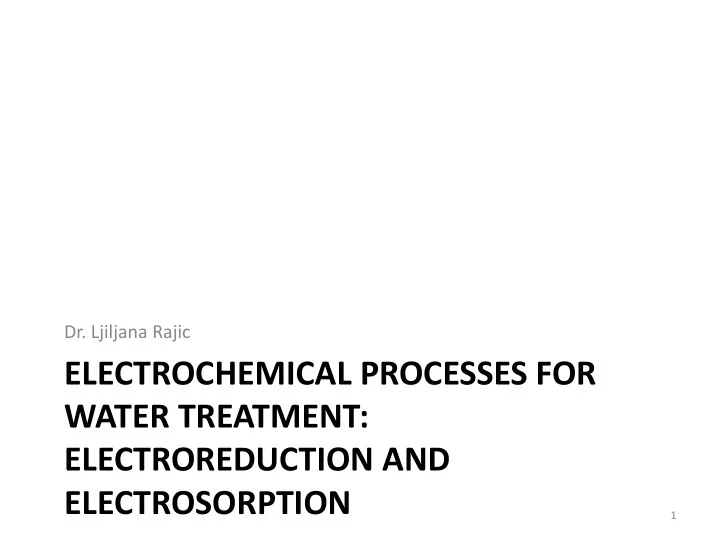

Dr. Ljiljana Rajic ELECTROCHEMICAL PROCESSES FOR WATER TREATMENT: ELECTROREDUCTION AND ELECTROSORPTION 1
Focus of today’s lecture • Electroreduction and indirect oxidation processes, and their use for groundwater treatment • Electrosorption: Salts removal for water desalination (process called Capacitive Deionization or CDI) and organics removal 2
Part 1 PROCESSES DRIVEN BY FARADAIC REACTIONS AT THE CATHODE 3
Faradaic reactions Occur when charges (e.g., electrons) are transferred across the metal-solution interface. Electron transfer causes oxidation or reduction to occur (these are governed by Faraday Law’s). Give few examples? When it comes to electrochemical transformation/removal of water pollutants… 4
Direct and indirect degradation processes induced by Faradaic reactions Oxidation Reduction Direct Direct (electrolysis) (electrolysis) at the anode at the cathode Indirect Indirect mediated by mediated by anode cathode Indirect Indirect mediated by mediated by cathode anode 5
INDIRECT REDUCTION MEDIATED BY CATHODE 6
Hydrodechlorination or HDC • e.g. tetrachloroethylene, thrichloroethylene, chlorophenol, chlorobenzene 7
Hydrodechlorination or HDC Electrochemical reduction through hydrodechlorination (HDC) occurs at the cathode due to water electrolysis (hydrogen evolution reaction or HER). Step 1: Process starts with electrochemical hydrogen adsorption (Volmer reaction) where atomic hydrogen (H a ) is chemically adsorbed on active site of the electrode surface (M) 8
Hydrodechlorination or HDC Electrochemical reduction through hydrodechlorination (HDC) occurs at the cathode due to water electrolysis. Step 2: The H a further involves in electrochemical desorption (Heyrovsky reaction) 9
Hydrodechlorination or HDC Electrochemical reduction through hydrodechlorination (HDC) occurs at the cathode due to water electrolysis. Step 2: OR chemical desorption (Tafel reaction) to create hydrogen gas or interacts with the reducible molecules like chlorinated substances, which leads to HDC . 10
Influence of cathode material The good HDC catalyst should have strong bond with H a to allow proton- electron transfer process but weak enough to ensure the bond breaking and the product release. If the hydrogen-metal surface (H a -M) binding energy is too high, adsorption is slow and limits the overall rate but if it is too low, desorption is Trassati’s volcano plot for the HER in acid solutions. j 00 slow. denotes the exchange current density, and E MH the energy of hydride formation 11
Modern “Volcano” plots There is a clear separation into three groups: sp metals, which are the worst catalysts, coinage metals, which are intermediate, and the d metals, which contain the best catalysts, but also Ni and Co, which are mediocre. 12
What has major effect on HDC? 13
Same cathodes and process but for different contaminant removal? 14
PRACTICAL APPLICATIONS 15
Approach 1 16
17
18
19
20
Approach 2 21
22
Results Anode: Cathode: Over 90% degradation of TCE can be achieved without formation of DCE or VC 23
Another effect on HDC? Competitive reactions: O 2 reduction! 24
INDIRECT OXIDATION MEDIATED BY CATHODE 25
Indirect oxidation processes Cathodes can support formation of H 2 O 2 via 2- electron O 2 reduction reaction (2e ORR) 26
Cathode material
Cathode material 28
Cathode material Modifications: heteroatom-doping (i.e. oxygen- containing functional groups) Hydrogen peroxide generation 29
Cathode material 30
31
Part 2 ELECTROSORPTION: SALTS REMOVAL FOR WATER DESALINATION (PROCESS CALLED CAPACITIVE DEIONIZATION OR CDI) AND ORGANICS REMOVAL 32
Electrosorption Charge separates across the interface, resulting in the formation of strong electrical double • layers (EDL) near the high conductivity and high surface area surfaces. When the electrode is charged and put into a solution with ions, the interface of the charged electrode and ions rich solution will be occupied with counter ions as a result of the Coulomb force, forming EDL. Under some conditions, a given electrode-solution interface will show a range of potentials where no • charge-transfer reactions occur because such reactions are thermodynamically or kinetically unfavorable. Charge does not cross the interface but external currents can flow! 33
Electrosorption 34
Electrosorption Accelerating the adsorption rate Ability for regeneration Anionic dye removal efficiency (%) 35
Electrosorption 36
Capacitive deionization or CDI Upon applying a voltage difference between two porous carbon electrodes, ions are attracted to the oppositely charged electrode. As a result, desalinated water is produced. 37
Mechanism Capacitive ion storage is the phenomenon of the formation of an electrical double layer (EDL), where upon applying a charge, ions are captured electrostatically and stored capacitively in the diffuse layer formed next to the carbon interface. The formation of the capacitive EDL is the heart of the CDI process.
Types of reactors 39
References Zhou et al., Hydrogen peroxide generation from O 2 electroreduction for environmental • remediation: A state-of-the-art review, Chemosphere 225 (2019) 588-607 Rajic et al., The influence of cathode material on electrochemical degradation of trichloroethylene • in aqueous solution, Chemosphere 147 (2016) 98-104 Rajic et al., Electrochemically-induced reduction of nitrate in aqueous solution, Int. J. Electrochem. • Sci. 12 (2017) 5998-6009. Ban et al., Fundamentals of electrosorption on activated carbon for wastewater treatment of • industrial effluents, Journal of Applied Electrochemistry 28 (1998) 227-236 Porada et at., Review on the science and technology of water desalination by capacitive • deionization, Progress in Materials Science 58 (2013) 1388–1442 Foo & Hameed, A short review of activated carbon assisted electrosorption process: An overview, • current stage and future prospects, Journal of Hazardous Materials 170 (2009) 552–559 Bayram & Ayranci, Electrosorption based waste water treatment system using activated carbon • cloth electrode: Electrosorption of benzoic acid from a flow-through electrolytic cell, Separation and Purification Technology 86 (2012) 113–118 Koparal et al., Electroadsorption of Acilan Blau dye from textile effluents by using activated carbon- • perlite mixtures, Water Environment Research 74( 2002), 521-525 Quaino et al. Volcano plots in hydrogen electrocatalysis - uses and abuses, Beilstein journal of • nanotechnology 5 (2014) 846-854 40
Recommend
More recommend